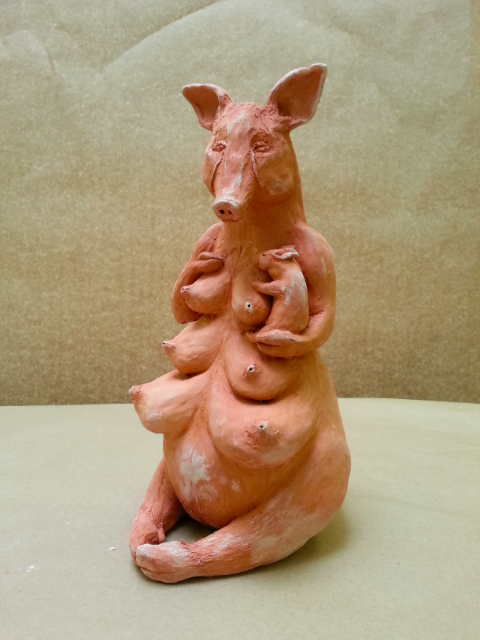Sacred Motherhood in Amy Lyn Brand’s “Mother Sow II”
Mother Sow II, 13″ x 6″ x 8″, terra cotta
(Copyright 2013, Amy Lyn Brand. All Rights Reserved).
Influenced in particular by the spiritual and philosophical ideas of the Fluxus artists of the 1960s and 1970s, intellectual descendants of Marcel Duchamp and the avant-garde, as well as by Ellen Dissanayake’s writings on art, spirituality and culture, Artist Amy Lyn Brand blends the spiritual and the material in her artwork. More specifically, the spirituality of Brand’s work often centers on the mother figure and the maternal flesh.
Brand’s Mother Sow II is a meditation on motherhood through the figure of the sow, whose sole piglet nestles closely atop the full udders of its mother. Full bodied and robust, the mother sow’s face expresses sadness or nostalgia, and the piglet’s embrace is tender. While creating the work in clay, Brand came across Galway Kinnell’s poem on Saint Francis and the sow. Brand has described the image, its making, and the influence of the poem on her work in detail to me through our correspondence:
For this body of work, I am creating a sort of pantheon of personal gods or spirits to help me through life. The Sow is a mother figure, who helps me through each new stage of motherhood. When I first sculpted her, in the spring of 2013, my children were one and three. The one year old was still breast-feeding, but I knew I would be weaning her over the next few months, and was already grieving that separation. The three year old would be starting pre-school in the fall. Pre-school was just for two mornings a week, but it felt like the first step in the process of leaving forever.
As I was searching for reference images of sows, I stumbled across the poem Saint Francis and the Sow, by Galway Kinnell, on a Momastery blog post. Something about that poem struck a chord in me, though it’s difficult for me to define what it was, because every time I read it, I find something new. And every time I sculpt the Sow, I depict a slightly different aspect of her – happiness, sorrow, beauty, ugliness. If I were to make a new image of her right now it would probably be one of exhaustion! But this figure, Sow II (my second depiction of her) should probably be titled Our Lady Sow of Sorrow. There’s a certain poignancy you experience as a mother – I remember it really striking me right after my first baby was born – of realizing that every human being was once a perfect, tiny baby. When you think about that, you realize how sad it is that those babies grow up and become adults who do horrible things, and have horrible things done to them. Every person you meet, no matter how unpleasant, was once a baby who had a mother.
There’s a joy in watching your children grow up, but also a sadness. With every step they take toward independence you rejoice, but your heart also breaks a little bit.
Saint Francis And The Sow
The bud
stands for all things,
even for those things that don’t flower,
for everything flowers, from within, of self-blessing;
though sometimes it is necessary
to reteach a thing its loveliness,
to put a hand on its brow
of the flower
and retell it in words and in touch
it is lovely
until it flowers again from within, of self-blessing;
as Saint Francis
put his hand on the creased forehead
of the sow, and told her in words and in touch
blessings of earth on the sow, and the sow
began remembering all down her thick length,
from the earthen snout all the way
through the fodder and slops to the spiritual curl of the tail,
from the hard spininess spiked out from the spine
down through the great broken heart
to the blue milken dreaminess spurting and shuddering
from the fourteen teats into the fourteen mouths sucking and blowing beneath
them:
the long, perfect loveliness of sow.Galway Kinnell, “Saint Francis and the Sow” from Three Books. Copyright © 2002 by Galway Kinnell.
Brand has also written more broadly on the topic of art as spiritual practice, expressing how art is a means through which the spirituality of life may be rendered in material form. In Mother Sow II, Brand has infused the simple figure of a pig with layers of meaning related to the spirituality of motherhood. More recently, the artist also incorporated the Sow II figure into a larger piece, a Reliquary, which is like an altar (see below).
On a formal level, Brand’s Mother Sow II brings to mind the powerful multi-breasted figure of Cybele, Phrygian Goddess of Fertility. Women interested in using the Mother Sow II figure in the visualization of birth or motherhood may meditate on the physicality of the figure’s form which is round and appears highly capable of birth.
Amy Lyn Brand is a Philadelphia based artist. More of her work may be viewed or she may be contacted through her website.
Reliquary, Installation view, Aprox. 36″ x 40″ x 40″ (dimensions variable), Terra-cotta with mixed media
(Copyright 2013, Amy Lyn Brand. All Rights Reserved)
Reliquary detail, 36″ x 40″ x 40″ (dimensions variable), Terra-cotta and mixed media
(Copyright 2013, Amy Lyn Brand. All Rights Reserved)


